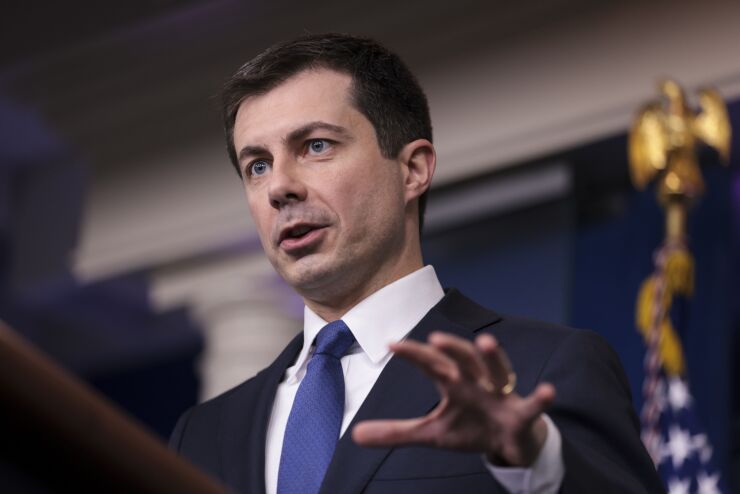The Department of Transportation announced the winners of $970 million in federal grants heading to 125 US airports spreading across 46 states, Guam, and Palau.
“Investing in America’s airport infrastructure isn’t just about upgrading runways and terminals, it’s about growing local economies, creating jobs, and ensuring the safety and efficiency of travel,” said U.S. Transportation Secretary Pete Buttigieg.
The money, announced Thursday, is the fourth infusion of modernization funding flowing through the Bipartisan Infrastructure Law. The tranche is targeted at “new baggage systems, larger security checkpoints, increasing gate capacity, and modernizing aging infrastructure throughout terminals and ground transportation.”
Bloomberg News
DOT divvies up the funding into several goal-oriented buckets including building or expanding new terminals, boosting competition among airlines, improving access to other modes of transportation, renovating control towers, increasing sustainability efforts and improving access to regional airports.
Florida’s Tampa International Airport is the big winner, netting $40 million to connect terminal D to the main terminal via a people mover. The addition is part of a $1.5 billion expansion of the airport as it anticipates a 40% increase in passengers by 2037. About $896 million is expected to be financed by new debt.
In
Austin-Bergstrom International Airport in Texas landed $33.2 million in new funding to build out a portion of their Midfield Terminal B project, which will add at least 20 new gates and construct a 518-foot underground tunnel connecting to the existing terminal.
Rep. Lloyd Doggett D- Texas, who serves on the House Ways and Means Committee said, “This investment represents the next step in the near doubling of the capacity at our overcrowded airport. The Infrastructure Law I strongly supported alongside my Democratic colleagues continues to deliver.”
The project will also add more restaurants, shops, lounges, and live music venues in the terminal. The new money is part of $47.52 million in federal funding for Bergstrom that’s been flown in by the FAA’s Airport Terminal Program.
In April, KBRA reaffirmed a AA- rating with a stable outlook for the airport’s revenue bonds based on the area’s vibrant economy, passenger growth, and “Well-managed financial operations characterized by high debt service coverage and substantial liquidity.”
Moody’s Ratings has the airport pegged at A1, while S&P Global ratings put it at A-plus.
Other grant winners include international airports in Denver, Salt Lake City, Bozeman, Nashville, Buffalo, and Memphis.
In June the Transportation Security Administration announced a record-breaking number of daily airport screenings of nearly 3-million travelers, indicating a total recovery from the pandemic.
According to the Airports Council International – North America, as of last year, the nation’s airports need $115 billion in infrastructure updates. Per ACI-NA, “over the past decade, about 60 percent of bonds issued to finance airport capital projects were issued as Private Activity Bonds.”
The organization continually advocates for bolstering bond financing with raising the Passenger Facility Charge, a local user fee that has remained frozen at $4.50 a head per flight segment since 2001.
